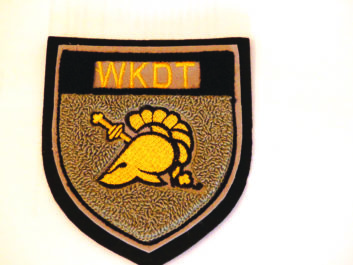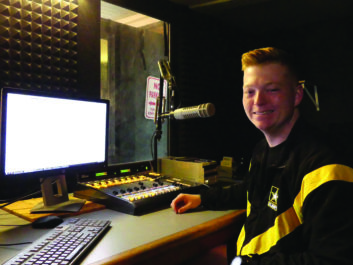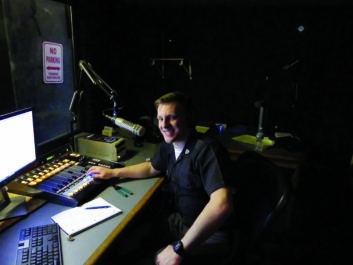
The Long Gray Line of cadets at the United States Military Academy, West Point, N.Y., has had a radio voice for years. On carrier current back in the day, low-powered FM and now online, WKDT Radio has long been the West Point cadet soundtrack.
WKDT started in 1954 as a carrier current station (KKDT) so cadets in the cadet barracks at West Point could listen on AM.
In 1972, WKDT began broadcasting on FM, thanks to a Memorandum of Understanding between the FCC and the Department of the Army, allowing the Army to operate a transmitter on 89.3 FM with the proviso that no interference to licensed stations on that frequency be transmitted. That memo adorns the walls of WKDT’s offices on the second floor of a student activity building in the shadows of Eisenhower Hall.
With most of the Military Academy at West Point surrounded by impenetrable granite, preventing interference has been easy to do, says Officer In Charge Joseph Cyr. For many years, the station has been an internal communications vehicle for staff, faculty and cadets. With an increased online presence, (893wkdt.com, Google Play and Apple App Store), Cyr says WKDT will become even more of a public face of the academy.
CADET CLUB

WKDT is a club that cadets can join as an extracurricular activity. Cyr says his goal is to make sure the cadets who volunteer have fun within the guidelines of the academy. “When you join [WKDT], you are committing yourself to entertain others.”
The WKDT schedule is a mix of music and sports and talk, live and automated. Cadets are in bed by 11:30 at night, so the cadet volunteers at WKDT produce programs to cover 24 hours. They do this while juggling a heavy course load, athletics and military instruction.
Dr. Lissa Young (’86) is the officer representative from the faculty. Young believes the live element in programming is important and also poses its own set of challenges. “What we have to be careful [about] is interfering with their study time. If we can get upperclassmen to come down and volunteer to run a live show, that keeps that connection.”
WKDT club members also provide public address and DJ support for cadet events.
Nicholas Levay (’19) served as the cadet general manager of WKDT. Before he came to West Point, Levay worked as a live event DJ. He says joining the station helped him deal with the challenges of cadet life.
[Community Broadcaster: College Radio Shows the Way]

“A lot of cadets find stress relief in the clubs and organizations they join. It is a lot of work, but it’s things I like to do,” Levay says. “I think the radio station and Joe and the friends I’ve made here are really what’s kept me at the academy. Without this outlet to express myself creatively outside of a military environment, I don’t think I would have lasted long at the academy.”
Even after graduation, graduates look back fondly on the station. Lt. Col (Ret.) Kathryn Donnelly (’90), an attorney with the Tully Rinckey law firm, remembers WKDT. At that time, “plebes” (freshmen) could not have radios, etc. until the second semester of the freshman year.
“WKDT was like Pandora, Netflix, CNN and Facebook rolled into one,” she says. “After five months of listening to the same tape they blasted over the loudspeakers at 0-dark-thirty, hearing Run DMC, Bon Jovi, Cyndi Lauper along with the dark cadet humor and eventually, Milli Vanilli, was a great relief. It made the un-college more college-like. Everyone listened.”
WKDT, ADD ONE
One of the reasons the cadets and alumni like to listen to WKDT is their sports coverage. The station and staff make no apologies for being “homers” when broadcasting West Point sports events.
Erick Loe (’20) was the radio manager during Army football’s successful 2018 season. Loe says WKDT provides a perspective that the commercial rights holder broadcast wouldn’t. “I’ve called West Point football games for the past three seasons. On our broadcasts, we come up with things, personal stories about the players and cadet life.”

For example, Loe and Army quarterback Calvin Hopkins were roommates during cadet basic training.
Loe says, “So when we get on the radio, families and listeners to us are going to be listening for that cadet appeal. That’s what our listeners want to hear.”
When we visited, the studios were being refitted with SAS iSL 12.2 consoles connected to a Rio Bravo audio engine with 64 channels of Dante AoIP audio. Announce and guest microphones are ElectroVoice RE-20s, processed by dbx 286 processors. According to Nick Straka of NS Radio Engineering, which provides technical support at the station, the transmitter is a Crown FM-100 running about 100 watts into a two-bay OMB ring-stub antenna.
Cyr has guided WKDT for 34 years. In that time, one thing has stayed constant, he says. “I have the best kids in the corps.”
Paul Kaminski has been a Radio World contributor since 1997. He is retired from the United States Army and can be reached on Twitter (@msrpk_com) and Facebook (Pkaminski2468).







